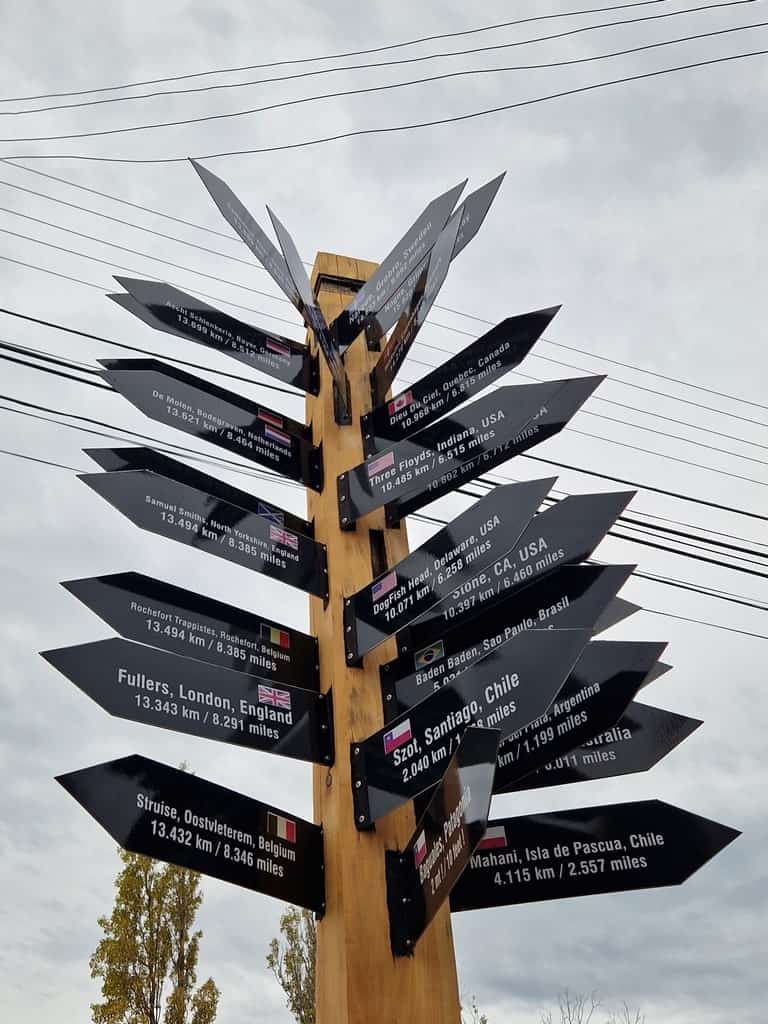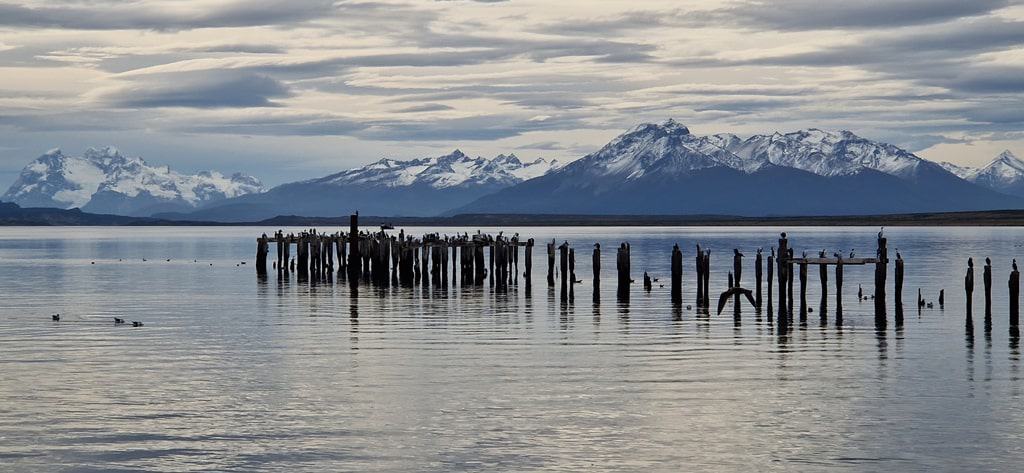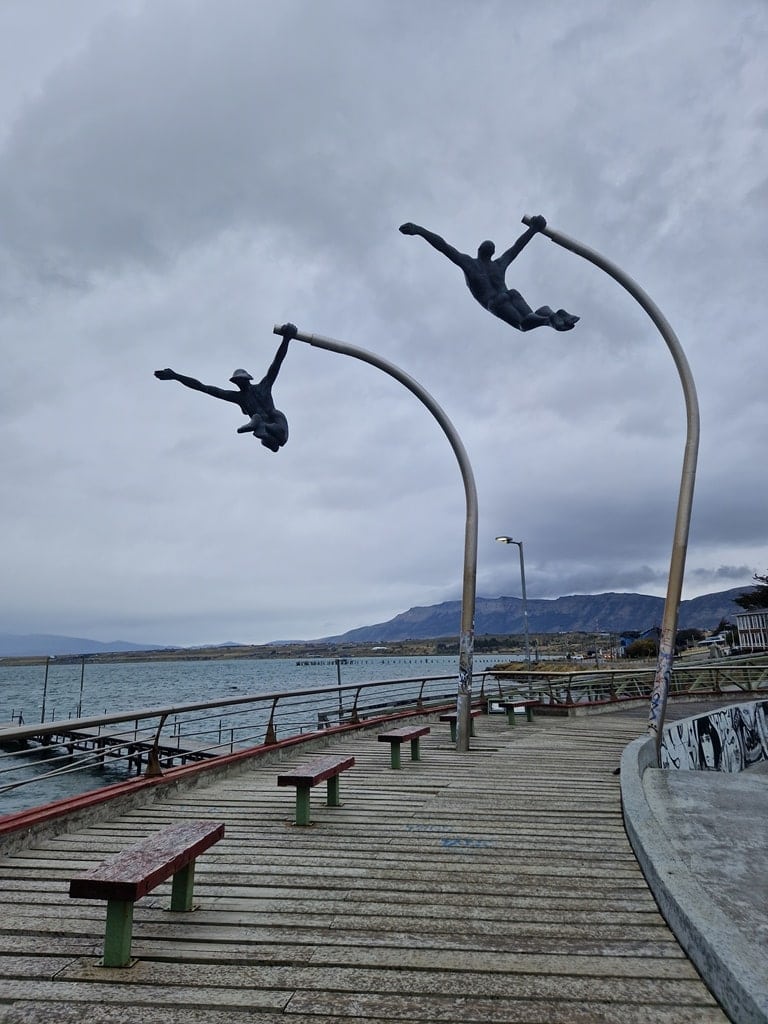Once a quiet fishing town, Puerto Natales has grown to become a popular gateway to a collection of national parks. Home to only around 20,000 local inhabitants, the sprawling urban area sits between the waters of the Señoret Canal and the backdrop of the Torres del Paine.
I totally recommend visiting the town as it offers days of exploring interesting local sights, compact cultural gems, and a surprising range of delicious gastronomic delights. The unfussy town may not be the most attractive in Chile, but with its weathered buildings and low-key atmosphere Puerto Natales’ charm is found in its cosy accommodation and warming social hubs.
Take some time to relax and unwind in this far-flung corner of Chile and prepare yourself for some amazing adventures ahead. Here’s a helpful guide for what to do in Puerto Natales, along with some tips on where to stay and how to get there.
Here is how my friends and I spent a few days exploring Puerto Natales and the surrounding area.
Disclaimer: This post contains affiliate links. This means that should you click on certain links, and then subsequently purchase a product, I will receive a small commission.

Table of Contents
A Guide to Puerto Natales, Chile
How to get to Puerto Natales
By Plane: The Teniente Julio Gallardo Airport serves Puerto Natales. Located 7 kilometers to the north of the town, it is also the closest airport to Torres del Paine National Park.
Flights leave around every other day from Santiago airport, with flights leaving more frequently during the peak travel season between October and March. The journey takes around 3 hours to fly between the two destinations. Tickets cost between $60 and $220 for a one-way journey. It’s best to book as far in advance as possible to secure a lower-priced fare.
To get to Puerto Natales from the airport you can take a taxi from the taxi rank outside the arrivals area. The taxi should cost around $8 to $9. There’s also the option of taking one of the airport shuttles that run between the airport and the town. This is the more cost-effective mode of transport if you’re traveling alone.
By Plane + Bus: Another way to get to Puerto Natales is to fly to Punta Arenas and then take a bus to Puerto Natales. The bus ride takes approximately 3 hours. Flights to Punta Arenas are year round so if you are flying off-season that is your best option.

Where to stay in Puerto Natales
Hotel Costaustralis: Located on the waterfront, this stylish hotel is one of the best places to stay when visiting Puerto Natales. Designed in a chateau style, the accommodation provides a selection of comfortable rooms where you can spend time unwinding after a busy time adventuring in the surrounding national parks.
The on-site amenities include a restaurant, a late-night pisco sour bar, and a well-stocked wine cellar. Days here start with a freshly cooked buffet breakfast and then you can choose to either spend time soaking up the mountain views or make the quick journey into the center of town.
Click here for more information and to check the latest prices.
Singular Hotel: The Singular Patagonia Hotel provides an all-around place to stay, play, and relax in Puerto Natales. Set among the breathtaking landscape, the property is located just a short drive from the center of town.
Throughout the hotel has been designed with aesthetically pleasing interiors and beautiful guest rooms that feature panoramic views and large beds. When it comes to dining guests can indulge in meals at the Singular restaurant, opt for a more casual setting at El Asador, or enjoy nibbles at the cocktail bar. Guests can also enjoy the use of an indoor and outdoor pool, a spa, and a wellness center among other amenities.
Click here for more information and to book your stay.
Things to do in Puerto Natales
Museo Histórico
The Municipal Historical Museum is a good place to start your trip to Puerto Natales.
Opening its doors in April 1990, the local museum is situated inside an old building which reflects the type of architecture the early English pioneers would have lived in. The museum’s collection is spread across 5 different spaces and charts the area’s history with a range of different artifacts and photography.
The museum’s collection is spread across five different spaces and focuses on the early origins of the area, the original inhabitants of Patagonia, Colonization, Rural life, and Urban activities.
Notable artifacts to look out for include personal belongings such as a Yaghan canoe and weapons called Tehuelche bolas. It may not be the most in-depth history museum but there’s enough here to give you an introduction to the local history.
You can find more information on opening times and ticket prices here.
Walk by the waterfront

One of the best things to do while in Puerto Natales is to take a walk through the waterfront. Not only will you enjoy the breathtaking natural scenery but also an array of interesting monuments showcasing the town’s rich history and culture.
The Monumento al Viento (Monument to the Wind) is a homage to the powerful winds that sweep through this region.

Another monument you can see on the waterfront is the Monumento al Cazador (Monument to the Hunter which honors the area’s connections to nature and its hunting traditions. The statue depicts a hunter with his hunting dog.
Other monuments include the Monumento de la Mano (Hands Monument) and the Monumento de Milodon which depicts a giant type of sloth.

The waterfront also has a number of cafes and restaurants where you can enjoy a warm cup of coffee or some delicious seafood while admiring the snow-capped mountains as a backdrop.
Mirador Cerro Dorotea

Not too far outside of Puerto Natales is this beautiful viewpoint. You can get a quick 10-minute taxi ride along Highway 9 for around 10km to the start of the hike that leads to the viewpoint. The trail begins at a small farm and weaves its way uphill through a field and onto a wooded area which makes for an all-round attractive hike.
Once you reach the top of the hill you reach the flat rock which is the viewpoint. From here, all of your efforts will be rewarded with views out across to the town, across the plains of Patagonian the curving straits of the Gulf of Admiral Montt, and should stretch to the snowy south Patagonian peaks. Make sure to come prepared for the weather, the wind can be very strong as you hike so warm clothing is a must.
Torres del Paine

Many travelers make their way to Puerto Natales to use it as a jumping-off point for excursions further afield. The most popular trip from the town is to the famous Torres del Paine National Park.
One of the nation’s gold star attractions, the park is looked over by the enormous, towering mountains known collectively as the Torres. The Torres are made up of the 2,800-meter tall Torre Central, the 2,850-meter high Torre Sur, and the 2,248-meter Torre Norte.
But this national park is not just about its incredible peaks. Living among the landscape is a vast array of wildlife which includes hundreds of species of birds and mammals. And that’s without mentioning that it also boasts the world’s third-biggest ice field. It’s no wonder then that the Torres del Paine has been named a UNESCO World Biosphere Reserve.

Make time in your schedule for the stunning slice of Southern Patagonia. Open throughout the year, the best time to pay a visit is in the Southern Hemisphere spring and summer which runs between October and April.
Cueva del Milodón Natural Monument

This collection of caves and rock formations can be found around 24 kilometers outside of Puerto Natales. Known as the Cueva del Milodón Natural Monument, the historic site has been used since prehistoric times as an abode. The modern history of the site dates back to 1896 when an amazing discovery was made by famous explorer Hermann Eberhard.
The explorer found bone samples and hair inside the cave. On closer inspection, the hair did not belong to humans at all, instead, it originated from a Mylodon – a type of giant sloth. Now extinct, the sloth was alive during the last glacial period, around 11,700 years ago. The animal would have grown up to 4 meters in length and wear a coat of long, thick hair to help it survive the cold climate of Patagonia.
Visitors today are welcomed into the caves by a replica of a Mylodan and can enter the caverns to see unusual rock formations. The caves were also once inhabited by native peoples and there’s some interesting information on offer about how they may have lived, as well as details about the creatures who once roamed the wilds here.
Wine & Market

Pay a visit to this wine and food shop to pick up all of the provisions you might need for a dinner or a gourmet picnic. The store’s shelves are stocked with a collection of products sourced from across Chile. The fantastic collection of craft beer and wine choices makes it all the more enticing.


Wine drinkers may want to stop by in time for one of the regular sommelier-led wine tastings. I totally recommend this place if you want to take back home some local products.
Plaza de Armas Arturo Prat

Make sure to stop by the Plaza de Armas Arturo Prat, this central green space is a pretty spot to see a collection of local sights. Usually busy with people going about their daily business, it’s the ideal location for doing a spot of people-watching with a coffee in hand.
The park is shaded by several leafy trees and decorated with a series of trickling fountains. Simply find yourself a spot on one of the benches and while away some time soaking in the local life.
There are also a number of shops, eateries, and attractive old buildings that edge this public space. Make sure to take a look at the historic steam train that has been placed in the park, it was once used for transporting huge wagons filled with cattle through the plains of Patagonia.

Tip: If you want to buy souvenirs from your trip to the Chilean Patagonia we found the best options in Puerto Natales. The small town has several small shops selling good quality artisanal souvenirs. I bought all my gifts there and also brought home some beautiful mementos.
Bernardo O’Higgins National Park

The Torres del Paine National Park might be remote, but when it comes to off-the-beaten-track natural wilderness Bernardo O’Higgins National Park wins the title. Making up one of the country’s largest protected spaces, the enormous park spans multiple regions and is overlooked by skyscraper mountains and shaped by vast fjords.

The park’s remote location means that it’s much more difficult to access. Those who do make it to the wild landscape will find themselves sharing it with very few fellow adventurers.

We got the chance to visit a part of the National Park with this Glacier Tour departing from Puerto Natales. We sailed through the Ultima Esperanza Fjord, where we got to admire the Patagonian wildlife and the Balmaceda glacier. We then disembarked at the Bernardo O’Higgins National Park where we hiked to the Serrano Glacier Viewpoint.

Before heading back to Puerto Natales we had a delicious lunch at the Estancia Perales and on our way back we enjoyed a Whiskey aperitif with ice from the glacier.

I totally recommend this full-day glacier tour to everyone visiting Puerto Natales. It was definitely one of the highlights of our trip to the Chilean Patagonia.
Grey Glacier

Located in the vast South Patagonian Ice Field, the eye-catching Grey Glacier is an enormous ice formation that flows from Grey Lake. Measuring 6 kilometers wide and more than 30 meters in height, the glacier is an epic natural formation that can be seen on a hiking tour from Puerto Natales.
You can view the glacier at a few locations throughout the Torres del Paine National Park. One of the best viewpoints is just to the south of Grey Lake, another is from the viewpoint of the John Garner Pass. The best way to see this natural formation is by taking a trip there with a knowledgeable guide which can be arranged in Puerto Natales.
Where to eat and drink in Puerto Natales
Asador Patagónico: If you’re in search of a more upscale dinner while in Puerto Natales then you should make sure to book a table at Asador Patagónico. This Argentinian grill restaurant boasts a menu of barbecued steak and lamb, served with a side of salads and bread. Dishes are all perfectly complemented with a selection of delicious wines. Bon Appétit!
Cafe Kaiken: This cute café may be compact but it’s a warm and welcoming space where you can while away a few hours. The café is the brainchild of Santiago locals who moved out of the big city and decided to set up on the doorstep of wild natural landscapes. The kitchen serves up a choice of locally sourced ingredients cooked to perfection.
Favorite dishes include tomato ravioli, homemade spinach gnocchi, and slow-cooked beef. This is the kind of spot that is popular with a steady stream of locals thanks to the attentive service and affordability so make sure to arrive early to avoid disappointment.

Baguales Brewpub: After a big multi-day trek there’s nothing better than returning to civilization for a nice relaxing beer and bite to eat. This friendly microbrewery was set up by a group of friends who liked to climb together and then drink together. The beer here is brewed right there on site and they serve up a mean choice of burgers, ideal for refuelling. And with a second-floor seating area, there’s enough room for everyone to enjoy a pint or two.
Galpon Patagonia: With a beautiful location overlooking the water, this local cultural center provides the perfect backdrop to play host to a number of creative events. Housed inside the shell of a former 1920s industrial building, the creative space is decorated with shabby chic inters. Check out their rotating schedule of theatre performances and art exhibitions or come here to get some work done on your laptop at the onsite café.

